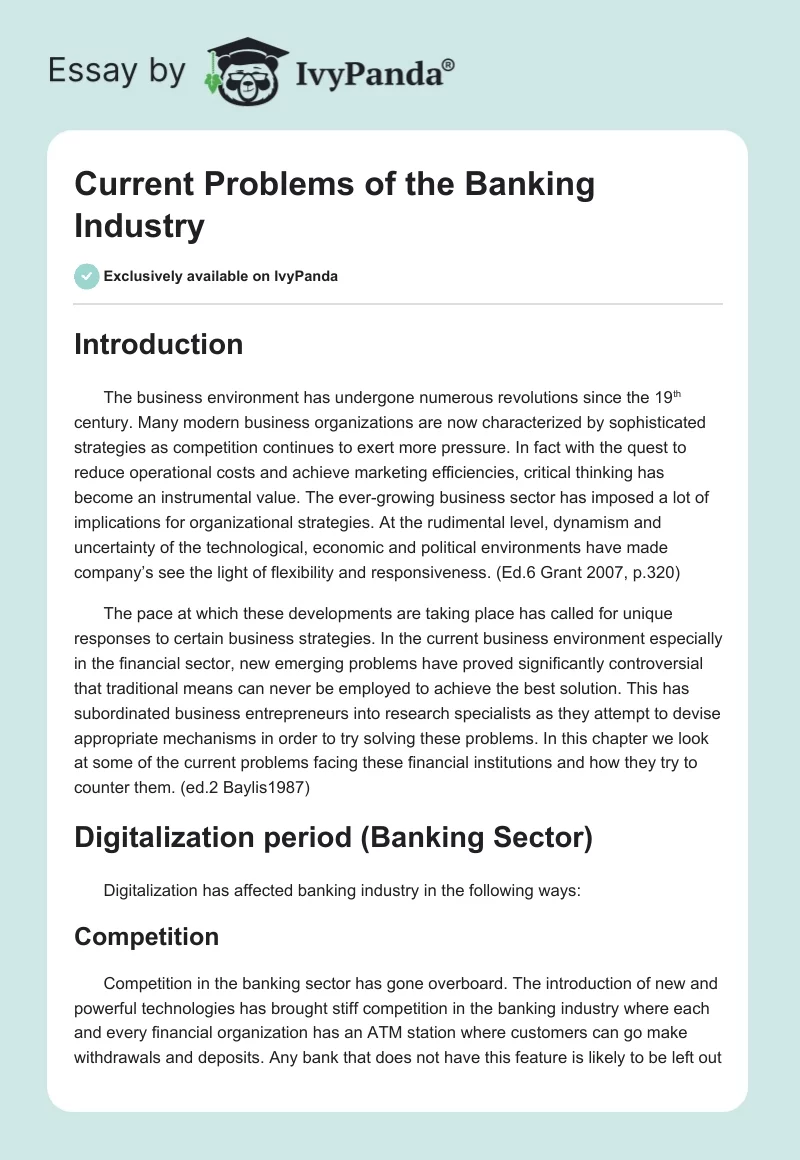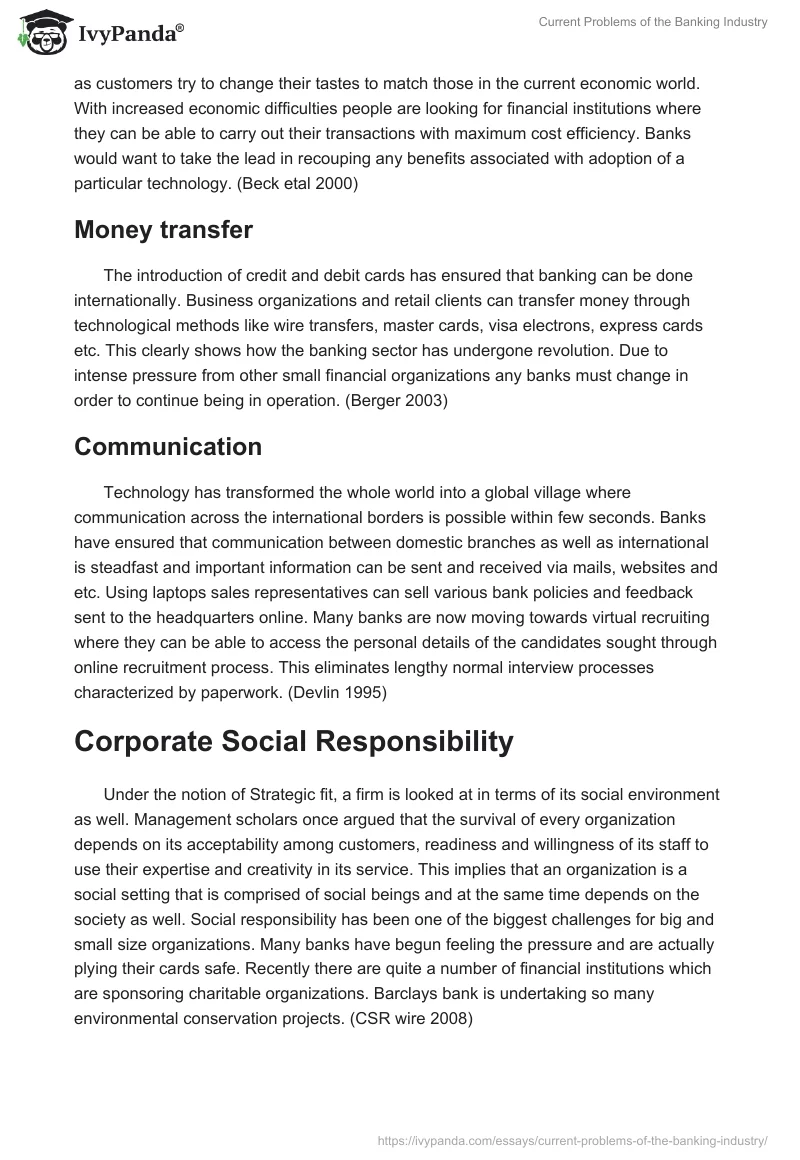Introduction
The business environment has undergone numerous revolutions since the 19th century. Many modern business organizations are now characterized by sophisticated strategies as competition continues to exert more pressure. In fact with the quest to reduce operational costs and achieve marketing efficiencies, critical thinking has become an instrumental value. The ever-growing business sector has imposed a lot of implications for organizational strategies. At the rudimental level, dynamism and uncertainty of the technological, economic and political environments have made company’s see the light of flexibility and responsiveness. (Ed.6 Grant 2007, p.320)
The pace at which these developments are taking place has called for unique responses to certain business strategies. In the current business environment especially in the financial sector, new emerging problems have proved significantly controversial that traditional means can never be employed to achieve the best solution. This has subordinated business entrepreneurs into research specialists as they attempt to devise appropriate mechanisms in order to try solving these problems. In this chapter we look at some of the current problems facing these financial institutions and how they try to counter them. (ed.2 Baylis1987)
Digitalization period (Banking Sector)
Digitalization has affected banking industry in the following ways:
Competition
Competition in the banking sector has gone overboard. The introduction of new and powerful technologies has brought stiff competition in the banking industry where each and every financial organization has an ATM station where customers can go make withdrawals and deposits. Any bank that does not have this feature is likely to be left out as customers try to change their tastes to match those in the current economic world. With increased economic difficulties people are looking for financial institutions where they can be able to carry out their transactions with maximum cost efficiency. Banks would want to take the lead in recouping any benefits associated with adoption of a particular technology. (Beck etal 2000)
Money transfer
The introduction of credit and debit cards has ensured that banking can be done internationally. Business organizations and retail clients can transfer money through technological methods like wire transfers, master cards, visa electrons, express cards etc. This clearly shows how the banking sector has undergone revolution. Due to intense pressure from other small financial organizations any banks must change in order to continue being in operation. (Berger 2003)
Communication
Technology has transformed the whole world into a global village where communication across the international borders is possible within few seconds. Banks have ensured that communication between domestic branches as well as international is steadfast and important information can be sent and received via mails, websites and etc. Using laptops sales representatives can sell various bank policies and feedback sent to the headquarters online. Many banks are now moving towards virtual recruiting where they can be able to access the personal details of the candidates sought through online recruitment process. This eliminates lengthy normal interview processes characterized by paperwork. (Devlin 1995)
Corporate Social Responsibility
Under the notion of Strategic fit, a firm is looked at in terms of its social environment as well. Management scholars once argued that the survival of every organization depends on its acceptability among customers, readiness and willingness of its staff to use their expertise and creativity in its service. This implies that an organization is a social setting that is comprised of social beings and at the same time depends on the society as well. Social responsibility has been one of the biggest challenges for big and small size organizations. Many banks have begun feeling the pressure and are actually plying their cards safe. Recently there are quite a number of financial institutions which are sponsoring charitable organizations. Barclays bank is undertaking so many environmental conservation projects. (CSR wire 2008)
Standard Chartered Bank is known to support many social events including sports where it has sponsored many athletic championships. An example of this includes the Boston marathon, Beijing and Olympic events. In Kenya for example Kenya Commercial bank is a major sponsor of a program dubbed Mercy Train. This is a program aimed at ensuring that the less fortunate and hungry people are fed by a donation received from well-wishing organizations and persons. (Devlin 1995)
Because banking institutions are private businesses with different shareholders, following the Enron scandal that left so many shareholders bankrupt, it is in the best interest that banks have initiated ethical practices including corporate governance, social ethics and etc. These practices are geared towards securing investors’ confidence so that they can develop a person that the activities of the organization are credible and transparent. (Berger 2003)
Privatizations in banking industry
This is one of the current trends in business; most banking organizations are now finding it increasingly strategic to join hands in the private sector than in corporations. Mergers and acquisitions have become the order of the day in business. One of the reasons that make banking organizations adopt this strategy is that there is a strong belief that privately-owned organizations are more cost-efficient than in the public sector. (JPMorgan 2008)
Secondly mergers and acquisitions create a platform for competitive advantages. This has been seen in many banking organizations as they try to form a formidable force to counter their rivals i.e. the Bank of India and the Bank of Africa recently agreed to share one banking network, the AIM alliance between the Apple and the Microsoft. The businesses are now trying to retreat under the anonymity afforded by private ownership. Business anonymity ensures that business strategy is not susceptible to any exposure. This will in turn make the business remain ever competitive. (Steven, et al 2006)Private organizations are more flexible and can therefore adapt to any kind of an environment. This makes the private entities to be more responsive to both local and international market needs.
Conclusion
Banks should ever remain conscious about the current digital era, look into the effects of the current technological advancement and review their strategy to determine if they are up to date and where possible make necessary adjustments. Strategy should now be tailored towards the needs of the business if maximum potential is to be achieved.
List of References
Beck, T etal 2000, Finance and the Sources of Growth, Journal of Financial Economics, Vol 58, no 1-2, pp.261-300.
Berger, A.N 2003, The economic effects of technological progress: Evidence from the Banking industry, Journal of Money, Credit, and Banking, Vol 35, no 2, pp.141-176.
Baylis, J (ed.2) 1987, Contemporary Strategy, Taylor & Francis, ISBN 0709950713, 9780709950714.
CSR wire 2008, The Latest Corporate Social Responsibility News –Banking on Sustainability, Web.
Devlin, J.F, 1995, Technology and Innovation in Retail Banking Distribution, International Journal of Banking Marketing, Vol 13, no 4, pp.19-25
Grant, R (ed.6) 2007, Contemporary strategy Analysis, Wiley, John & Sons, Incorporated, pp.210-496, ISBN-13: 9781405163095.
J.P.Morgan.2008, Private Banking, Web.
Steven F, Damien N, Paul S & Anita T,2006, Market entry, privatization and bank performance in transition, Journal compilation © 2009 The European Bank for Reconstruction and Development,Vol.14,no.4,pp.579-610.


